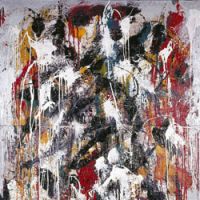Founded by Jiro Yoshihara and Shozo Shimamoto in 1954, the Gutai was an avant-garde group of Kansai-based artists. "Gutai" literally means "embodiment" and it reflected the young artists' goal to allow the nature of their materials to help embody a spirit of artistic freedom. The group's manifesto prohibited members from mimicking past works and genres, a policy that contributed to the organization's reputation of iconoclastic pieces in subsequent years.
While their nonconformist approach didn't appeal to Japanese critics, it was quick to gain international attention and the group held a number of retrospective exhibitions overseas before it disbanded in 1972. This exhibition marks the first time that the Gutai's entire 18-year activity is featured in Tokyo; till Sept. 10.
The National Art Center, Tokyo; (03) 5777-8600; 7-22-2, Roppongi, Minato-ku, Tokyo; Roppongi Station, Toei Oedo Line. 10 a.m.-6: p.m. ¥1,000. Closed Tue. www.nact.jp.

















With your current subscription plan you can comment on stories. However, before writing your first comment, please create a display name in the Profile section of your subscriber account page.